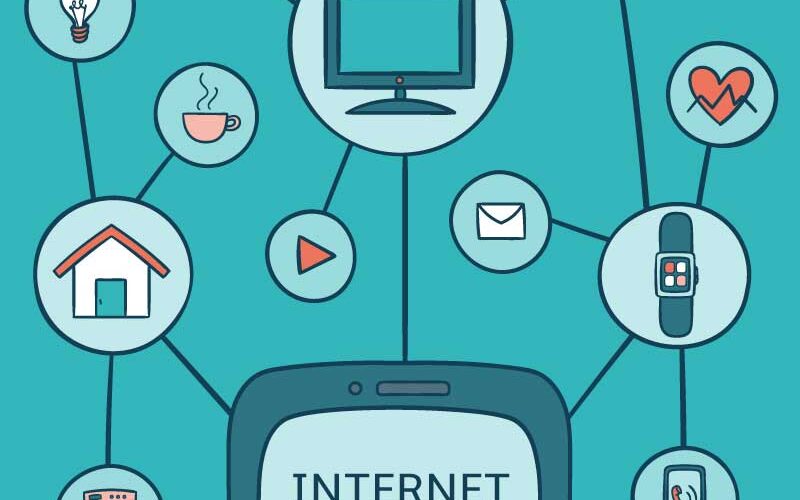IoT, which stands for Internet of Things, is the concept of making furniture be able to connect to the internet and interact with other furniture or the input of the user. For example, the user can program the curtain to be opened right after he wakes up. Or setting on the A/C when the user is on the way home. Even the IoT can tell the user that some foods in the refrigerator have passed their best-before date and buy some fresh ones by itself.
To make this possible, all things should be connected to one another and have to communicate continuously. For better effectiveness, electronic devices should be implemented in all appliances. So, the device should be small and hidden, and all the information should be secure to prevent it from being used in crimes (Clark, 2016).
The first concept of IoT started in the 1980s, and the term IoT was first used in 1999 by a computer scientist named Kevin Ashton. Then, in 2000, LG Electronics showed off one of the earliest IoT devices. It was a smart refrigerator. However, because of the high cost and limitations of computing power, it was not successful (Merchant, 2021).
Then, in 2006, the iPhone was announced, which allowed everybody to have their own personal computing device, which is the base of IoT because everybody having their own phone means everybody has a sensor that can track their movement or location and interact with other devices.
In 2012, Samsung introduced the ‘Samsung Smart’ things (Merchant, 2021). The thing that makes them is the IoT platform, which is made to help in communication between devices. It can give order to certain devices or groups of devices based on the simple ‘IF THEN code’ entered by the user. For example, IF the user leaves home, THEN turn off the light AND air conditioner AND turn on the robotic vacuum. When this code is pre-set, the location from my phone sends the current location of the phone, and when the phone’s location is off from the trigger barrier, the IoT hub will give a signal to the light, air conditioner, and robotic vacuum to do their jobs.
Then, in 2014, Apple also launched its own IoT platform called the Apple Home Kit. The home kit uses an Apple TV or home pod as the IoT hub. And since then, other companies have started the IoT business, and the IoT devices have also gotten smaller and smaller due to the improvement of computing technology. The size of a coin is needed to fit all the electronics that are needed (Ranger, 2020).
The growth of the IoT market has been rapid. The number of devices that support IoT and the number of IoT platforms grew significantly in the short term. This has recently become a problem. The compatibility of IoT devices is limited to a few platforms, and the number of platforms is almost countless. So, in some cases, the user needs to go through all different apps to turn on the lights in the house because there are a number of different kinds of light bulbs that support all different platforms. So, the IoT becomes ineffective by turning off the light manually.
To stop this irony, the number of companies discussed in one big group made the solution, and the solution was ‘matter’. The matter is the protocol that makes it possible to connect devices and systems with one another. So, this is a connection between IoT platforms. This makes it much easier for the user to use IoT because most IoT devices can now be controlled by one app. Also, the companies that made a difference made another solution, CSA, which stands for Connectivity Standards Alliance. This alliance maintains and updates the matter protocol and makes a certificate for IoT devices (CSA, n.d.) (Wikipedia contributors, 2023).
Reference list
Clark, J. (2016). What is the Internet of Things, and how does it work? [online] IBM Blog. Available at: https://www.ibm.com/blog/what-is-the-iot/ [Accessed 17 June 2023].
CSA. (n.d.). Matter | Smart Home Device Solution. [online] Available at: https://csa-iot.org/all-solutions/matter/ [Accessed 17 June 2023].
Merchant, N. (2021). IoT Technologies Explained: History, Examples, Risks & Future. [online] Vision of Humanity. Available at: https://www.visionofhumanity.org/what-is-the-internet-of-things/ [Accessed 17 June 2023].
Ranger, S. (2020). What is the IoT? Everything you need to know about the Internet of Things right now. [online] ZDNet. Available at: https://www.zdnet.com/article/what-is-the-internet-of-things-everything-you-need-to-know-about-the-iot-right-now/ [Accessed 17 June 2023].
Wikipedia contributors (2023). Matter (standard). [online] Wikipedia. Available at: https://en.wikipedia.org/wiki/Matter_(standard) [Accessed 17 June 2023].
